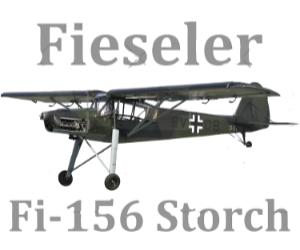 |
|
| Storch in flight at Flying Legends (July 2012) | |
| Role | Reconnaissance & communications |
|---|---|
| National origin | Nazi Germany |
| Manufacturer | Fieseler Morane-Saulnier |
| First flight | 24 May 1936 |
| Introduction | 1937 |
| Retired | Germany: 1945France: 1970 |
| Primary users | Luftwaffe French Army French Air Force |
| Produced | 1937–1949 (-1965 as the MS 500) |
| Number built | Over 2,900 |

The Fieseler Fi 156 Storch ([ʃtɔrç], "stork") was a liaison aircraft designed and produced by the German aircraft manufacturer Fieseler. Its nickname of Storch was derived from the lengthy legs of its main landing gear, which gave the aircraft a similar appearance to that of the long-legged, big-winged bird.

About 2,900 Fi 156s, the majority being of the Fi 156C model, were produced between 1937 and 1945.[5] The principal production line was at the Fieseler Factory in Kassel. During 1942, production started in the Morane-Saulnier factory at Puteaux in France. Due to the demand for Fieseler as a subcontractor for building the Fw 190, Fi 156 production was shifted to Leichtbau Budweis in Budweis by the end of 1943. Factories in other countries under German control manufactured aircraft, including Fi 156s, for Germany..
Even after the end of the conflict, production of the type continued in other countries into the 1950s, both for the private market and military operators. In addition to Germany, additional production lines had been established in France, Czechoslovakia, Romania, and the Soviet Union. Furthermore, there have been many attempts to recreate or imitate the Fi 156, including several three-quarter scale homebuilt aircraft, such as the Pazmany PL-9 Stork, RagWing RW19 Stork, and STOL King. The Slepcev Storch and French-built later variants of the original aircraft have often appeared at air shows and other flying events. Numerous flight-worthy aircraft are still operational into the twenty-first century.

Ceiling
MAX RANGE
Aircraft Speed
Max Crew


Both the French Air Force (Armée de l'Air) and the French Army Light Aviation (Aviation Légère de l’Armée de Terre) operated the Criquet between 1945 and 1958. Accordingly, the type saw battlefield service in French hands during both the Indochina War and the Algerian War.
The Swiss Air Force, as well as several other European countries, continued to use the Storch
The Swiss Air Force, as well as several other mountainous European countries, continued to use the Storch